check engine AUDI Q7 2012 Owner´s Manual
[x] Cancel search | Manufacturer: AUDI, Model Year: 2012, Model line: Q7, Model: AUDI Q7 2012Pages: 342, PDF Size: 86.42 MB
Page 4 of 342
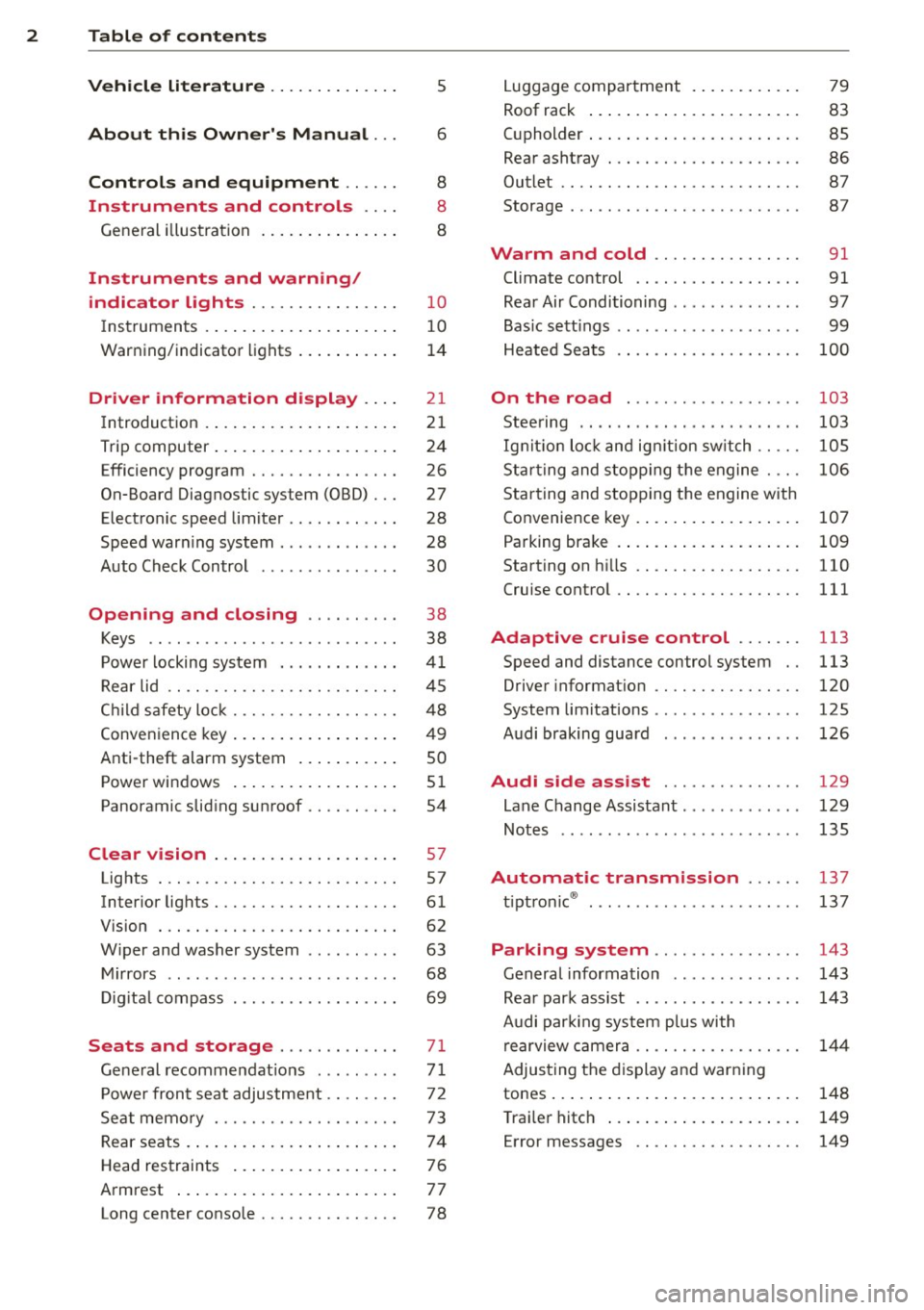
2 Table of contents Vehicle literature .. .. .. .. .. ... .
About this Owner's Manual ...
Controls and equipment .. ... .
Ins truments and controls .. . .
General illus tration .... ... .. .. ... .
Instruments and warning /
indicator lights ........ .. .. .. . .
Ins truments . .. .. ..... ... .. .. ... .
War ning/ indi cator lights ... .. ... .. .
Driver information d isplay .. . .
Introduct ion . .. .. ..... ... .. .. ... .
Trip computer .. .. ..... ... .. .. ... .
Efficiency program ........ .. .. ... .
On-Board Diagnostic system (OBD) . . .
Elect ronic speed limiter .. .. .. .. .. . .
Speed war ning system ...... ..... . .
Auto Check Control ........ ... .. . .
Opening and closing .. .. .. .. . .
Keys .. .. .. ................ ... . .
P owe r locking system . .. .. .. .. .. . .
R ear lid .. .. .. . .......... .. .. .. . .
C hild sa fety lo ck .......... .. .. .. . .
Conven ien ce key .. ..... ... .. .. ... .
Anti-theft alarm system ... .. ... .. .
Power win dows .. ..... ... .. .. ... .
Panoramic slid ing sun roof .. .. .. ... .
Clear vision .. .. ..... ... .. .. ... .
Lights . .. .. .. . .......... .. .. ... .
Inter ior lights ............. ... ... .
V 1s 1on . ...... ........... .... ... .
W iper and washer system . ... .. .. . .
M ir rors .. .. ................ ... . .
D ig ita l compass . ...... ... .. .. .. . .
Seats and storage ......... .. . .
G en eral recomme ndat ions ... .. .. . .
P owe r fron t seat adjus tment .. .. .. . .
Se at mem ory ............ .. .. ... .
Rear seats . ... . .. ..... ..... .. ... .
Head res traints .. ..... ... .. .. ... .
A rmrest .... .. .. ..... ... .. .. ... .
5
6
8
8
8
10
10
14
21
21
24
26
27
28
28
30
38
38
41
4 5
48
49
so
5 1
54
57
57
61
62
63
68
69
71
7 1
72
73
74
7 6
7 7
Long center conso le . . . . . . . . . . . . . . . 78 L
ugga ge compartment . ..... .... . .
Roof rack ..... .. .. ... ..... ... .. .
( upholder ... .. .. .. ... .. .. .. .. .. .
Rear asht ray ..... ............. .. .
Out let .... .... .. ............. .. .
Storage ...... ... .. ............. . 79
83
85
86
87
87
Warm and cold
. . . . . . . . . . . . . . . . 91
Climate control . . . . . . . . . . . . . . . . . . 91
Rea r Air Conditioning . . . . . . . . . . . . . . 97
Bas ic sett ings . . . . . . . . . . . . . . . . . . . . 99
Heated Sea ts . . . . . . . . . . . . . . . . . . . .
100
On the road . . . . . . . . . . . . . . . . . . . 103
Stee ring .. .. ... . .. ... .. ... ... .. . 103
Ig nition lo ck and ig nition sw itch . . . . . 105
St arti ng and sto pp ing t he engine . . . . 10 6
S tar ting and stopping the engine with
Co nvenience key . . . . . . . . . . . . . . . . . .
107
Pa rking bra ke . . . . . . . . . . . . . . . . . . . . 109
Starting on h ills . . . . . . . . . . . . . . . . . . 110
Cru ise contro l . . . . . . . . . . . . . . . . . . . . 111
Adaptive cruise control . . . . . . . 113
Speed and distance control system . . 113
Driver informat io n . . . . . . . . . . . . . . . . 120
System limitations . . . . . . . . . . . . . . . . 125
Audi braking gua rd . . . . . . . . . . . . . . . 126
Audi side assist . . . . . . . . . . . . . . . 129
Lane Change Assistant. . . . . . . . . . . . . 129
Not es . . . . . . . . . . . . . . . . . . . . . . . . . . 135
Automatic transmission ... .. .
t.
t . ® 1p ro ni c ..... .. .......... ... .. .
Parking system ... .. .. ... ..... .
General information ............. .
Rea r park assist .. ... ... .... ... .. .
Audi par king syste m plus with
re arview c amer a .. ............... .
Adjus ting the d is p lay a nd warning
tones ... .. .... .. ... .. ..... ... .. .
T ra ile r hitch ..... .. .... .... ... .. .
Error messages .. ... .......... .. .
137
137
143
143
143
14 4
148
149
149
Page 5 of 342
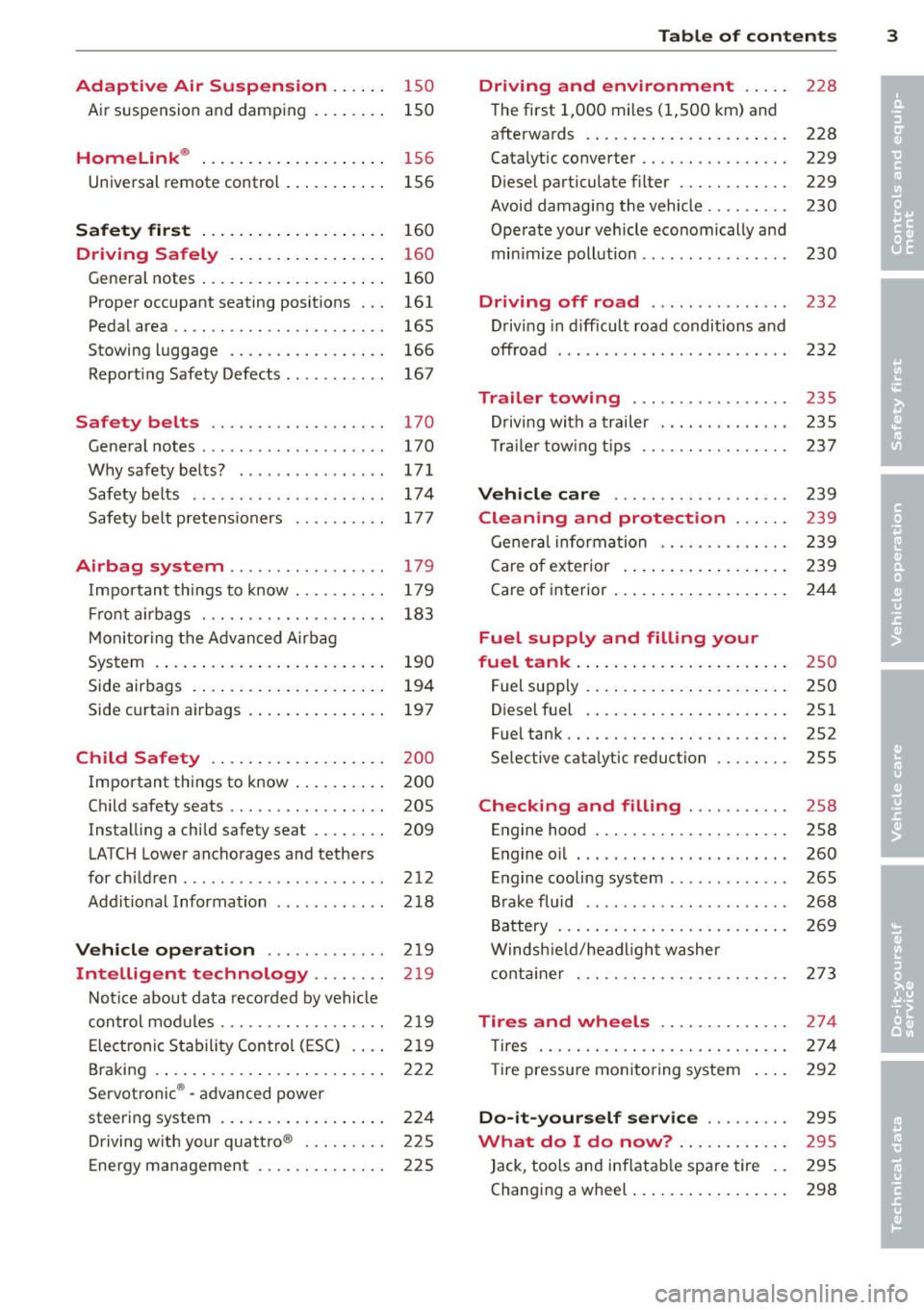
Adaptive Air Suspension .. .. . .
Air suspension and damping 150
150
Homelink ® . . . . . . . . . . . . . . . . . . . . 156
Universal remote control . . . . . . . . . . . 156
Safet y fir st . . . . . . . . . . . . . . . . . . . . 160
Driving Safely . . . . . . . . . . . . . . . . . 160
Gene ral notes . . . . . . . . . . . . . . . . . . . . 160
Proper occupant seating posit ions . . . 161
Ped al area . . . . . . . . . . . . . . . . . . . . . . . 165
Stowing luggage . . . . . . . . . . . . . . . . . 166
Report ing Safety Defects . . . . . . . . . . . 167
Safety belts . . . . . . . . . . . . . . . . . . . 170
General notes . . . . . . . . . . . . . . . . . . . . 170
Why safety belts? . . . . . . . . . . . . . . . . 171
Safety belts . . . . . . . . . . . . . . . . . . . . . 17 4
Safety bel t pretens ioners . . . . . . . . . . 177
Airbag system .......... ... ... .
Important things to know .. .. .. .. . .
Fr ont airbags ............ .... .. . .
M on itoring the A dvanced Airbag
System .... .. ... .. ..... ... .. .. . .
Side airbags . ... ...... ... .. .. .. . .
Side curtain airbags .... ... .. .. .. . .
Child Safety .. .. .... ... .. .. .. . .
Important th ings to know . ... .. .. . .
Ch ild safety seats ......... .... .. . .
Instal ling a child safety seat .. .. .. . .
LATC H Lower ancho rages and tethers
for chi ldren .... .. .. ...... .. .. .. . .
Addit ional Information
Vehicle operation ..... .. .. .. . .
Intelligent technology .. .. . .. .
179
179
183
190
194
197
200
200
205
209
212
218
219
219
Not ice about data recorded by vehi cle
con trol mod u Les . . . . . . . . . . . . . . . . . . 2 19
E lect ronic S tabili ty Control ( ES C) . . . . 219
Braking . . . . . . . . . . . . . . . . . . . . . . . . . 222
Servotronic ® -advanced power
steering system . . . . . . . . . . . . . . . . . . 224
Driving w ith your quattro ® . . . . . . . . . 225
Energy management . . . . . . . . . . . . . . 225
Table of contents 3
Driving and environment . . . . .
228
The first 1,000 miles (1,SOO km) and
afterwa rds . . . . . . . . . . . . . . . . . . . . . . 228
Catalytic co nverter . . . . . . . . . . . . . . . . 229
Diesel particulate filter . . . . . . . . . . . . 229
Avoid damaging the vehicle . . . . . . . . . 230
Operate your vehicle eco nomically and
min imize poll ution . . . . . . . . . . . . . . . . 230
Driving off road . . . . . . . . . . . . . . . 232
Driving in d ifficult road conditions and
offroad . . . . . . . . . . . . . . . . . . . . . . . . . 232
Trailer towing . . . . . . . . . . . . . . . . . 235
D riving with a trailer . . . . . . . . . . . . . . 235
T rai le r tow ing tips . . . . . . . . . . . . . . . . 237
Vehicle care . . . . . . . . . . . . . . . . . . . 239
Cleaning and protection . . . . . . 239
General information . . . . . . . . . . . . . . 239
Care of ex terior . ... .. .. .. .... ... .
Care of inte rior ... .. . .. .. ..... ... .
Fuel supply and filling your
fuel tank ... .... .. . .. .. ..... ... .
Fuel supply ...... .. . .. .. ..... ... .
Diesel f uel .. .. .. .. .. ... ..... ... .
Fuel tank .. .. .. .. .... ........... .
Se lective cata lytic reduction ..... .. .
Checking and filling .......... .
Engine hood ... .. ............... .
E n gine oi l ... .... ... .. .... ...... .
Engine cooling system .. .. ... ..... .
B rake fluid ....... ...... ........ .
B attery ... .. .. .. .. . ............ .
Windsh ie ld/headl ight washer
conta iner . .. .. .. .. ............. . 239
244
25
0
250
251
252
255
258
258
260
265
268
2 69
2 73
Tires and wheels . . . . . . . . . . . . . . 274
T ires . . . . . . . . . . . . . . . . . . . . . . . . . . . 274
T ire pressure monitoring system 292
Do -it -yourself service . . . . . . . . . 295
What do I do now? . . . . . . . . . . . . 295
Jack , tools and inflatab le spare tire . . 295
Changing a wheel . . . . . . . . . . . . . . . . . 298
•
•
Page 12 of 342
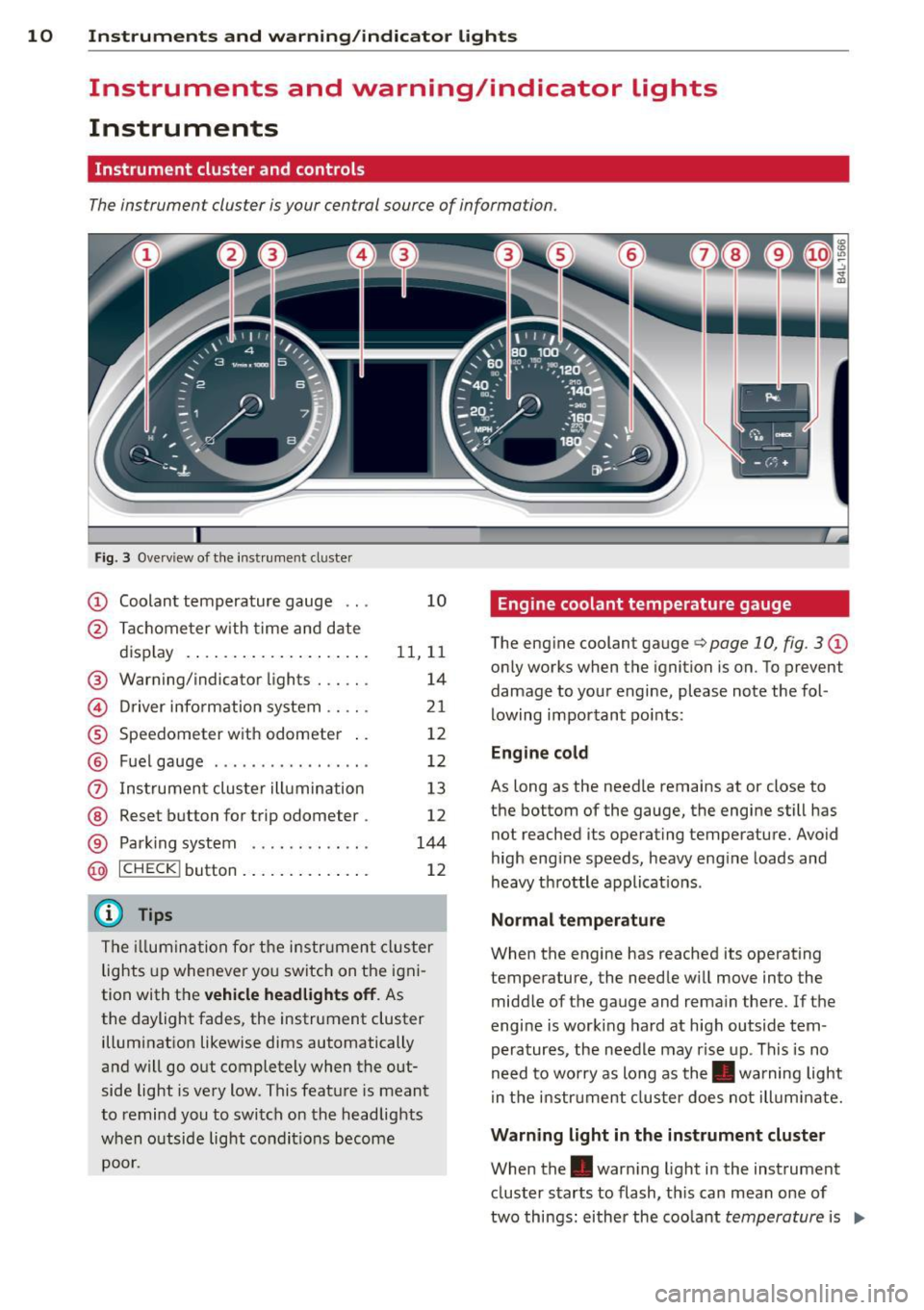
10 Instruments and warning/indicator lights
Instruments and warning/indicator Lights
Instruments
Instrument cluster and controls
The instrument cluster is your central source of information.
Fig. 3 Overv iew of the inst rument cluster
CD Coolant temperature gauge . . . 10
@ Tachometer with time and date
display . . . . . . . . . . . . . . . . . . . . 11, 11
® Warning/indicator lights . . . . . . 14
© Driver information system.. .. . 21
® Speedometer with odometer . . 12
® Fuel gauge . . . . . . . . . . . . . . . . . 12
(i) Instrument cluster illumination 13
@ Reset button for trip odometer . 12
® Parking system . . . . . . . . . . . . . 144
@ ICHECK I button . . . . . . . . . . . . . . 12
@ Tips
The illumina tion for the instr ument cluster
lights up whenever you switch on the igni
tion with the
vehicle headlights off. As
the daylight fades, the instrument cluster illumination likewise dims automatically
and will go out completely when the out
side light is very low. This feature is meant
to remind you to switch on the headlights
when outside light condit ions become
poor.
Engine coolant temperature gauge
The engine coolant gauge q page 10, fig. 3 CD
only works when the ignition is on. To prevent
damage to your engine, please note the fol
lowing important po ints:
Engine cold
As long as the needle remains at or close to
the bottom of the gauge, the engine still has
not reached its operating temperature. Avoid
high engine speeds, heavy engine loads and
heavy throttle applicat ions .
Normal temperature
When the engine has reached its operating
temperature, the needle will move into the
middle of the gauge and remain there. If the
engine is working hard at high outside tem
peratures, the needle may rise up. This is no
need to worry as long as the. warning light
in the instrument cluster does not illuminate.
Warning light in the instrument cluster
When the. warn ing light in the instrument
cluster starts to flash, th is can mean one of
two things: either the coolant
temperature is .,..
Page 13 of 342
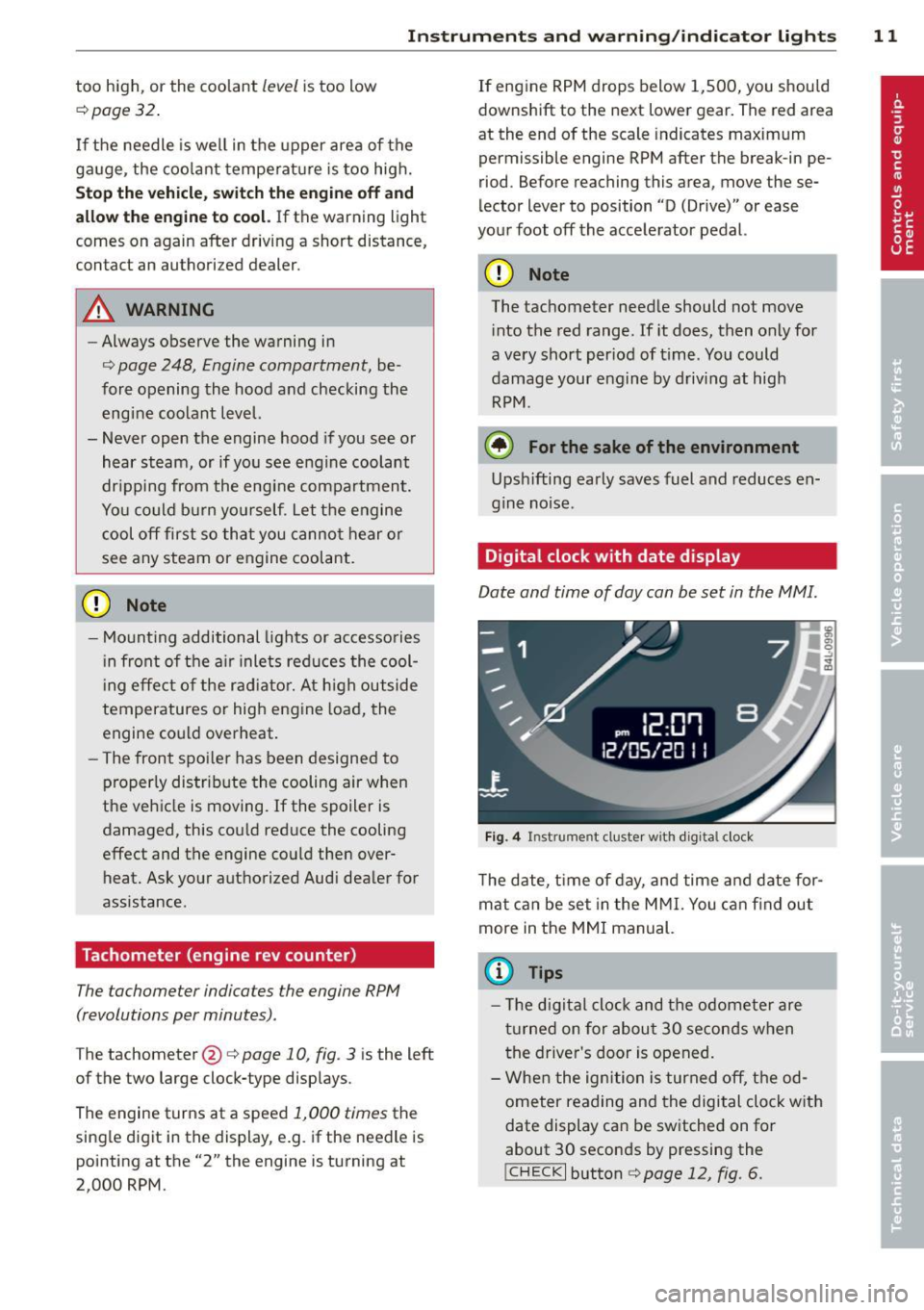
Instrument s and warning /indicator lights 11
too high, or the coolant level is too low
¢ page 32.
If the needle is well in the upper area of the
ga uge , the coolant temperature is too high.
Stop the vehicle , switch the eng ine off and
allow the engine to cool.
If the warning light
comes on again after driving a short distance,
contact an authorized dealer.
A WARNING
-Always observe the warning in
¢ page 248, Engine compartment, be
fore opening the hood and checking the
engine coolant level.
- Never open the engine hood if you see or
hear steam, or if you see engine coolant
dripping from the engine compartment.
You could burn yo urself. Let the engine
cool off first so that you cannot hear or
see any steam or engine coolant.
(D Note
- Mounting additional lights or accessories
i n front of the air inlets reduces the cool
in g effect of the rad iato r. At high outside
temperatures or high engine load, the
engine could overheat.
- The front spoi ler has been designed to
properly distribute the cooling air when
the vehicle is moving. If the spoiler is
damaged, this cou ld red uce the cooling
effect and the engine could then over
heat. Ask your authorized Aud i dealer for
assistance .
Tachometer (engine rev counter)
The tachometer indicates the engine RPM
(revolutions per minutes) .
The tachometer @¢ page 10, fig. 3 is the left
of the two large clock-type displays.
The engine turns at a speed
1,000 times the
single digit in the display, e.g . if the needle is
pointing at the "2" the engine is turning at
2,000 RPM. If
eng ine RPM drops below 1,500, you should
downshift to the next lower gear. The red area
at the end of the scale indicates maximum
permissible engine RPM after the break -in pe
riod. Before reaching this area, move these
lector lever to position "D (Drive)" or ease
your foot off the accelerator pedal.
Q) Note
The tachometer needle should not move
i nto the red range. If it does, then only for
a very short per iod of t i me. You could
damage your engine by driving at high
RPM .
@ For the sake of the environment
Upsh ifting early saves fuel and reduces en
gine noise .
Digital clock with date display
Date and time of day can be set in the MMI.
Fig. 4 Instrument cluster w ith digita l clock
The date, time of day, and time and date for
mat ca n be set in the MMI. You can find out
more in the MMI manual.
(D Tips
- The d ig ita l clock and the odometer are
turned on for about 30 seconds when
the driver's door is opened.
- When the ignition is turned off, the od
ometer reading and the digital clock w ith
date display can be switched on for
about 30 seconds by pressing the
! CHECK I button c> page 12, fig . 6.
Page 14 of 342
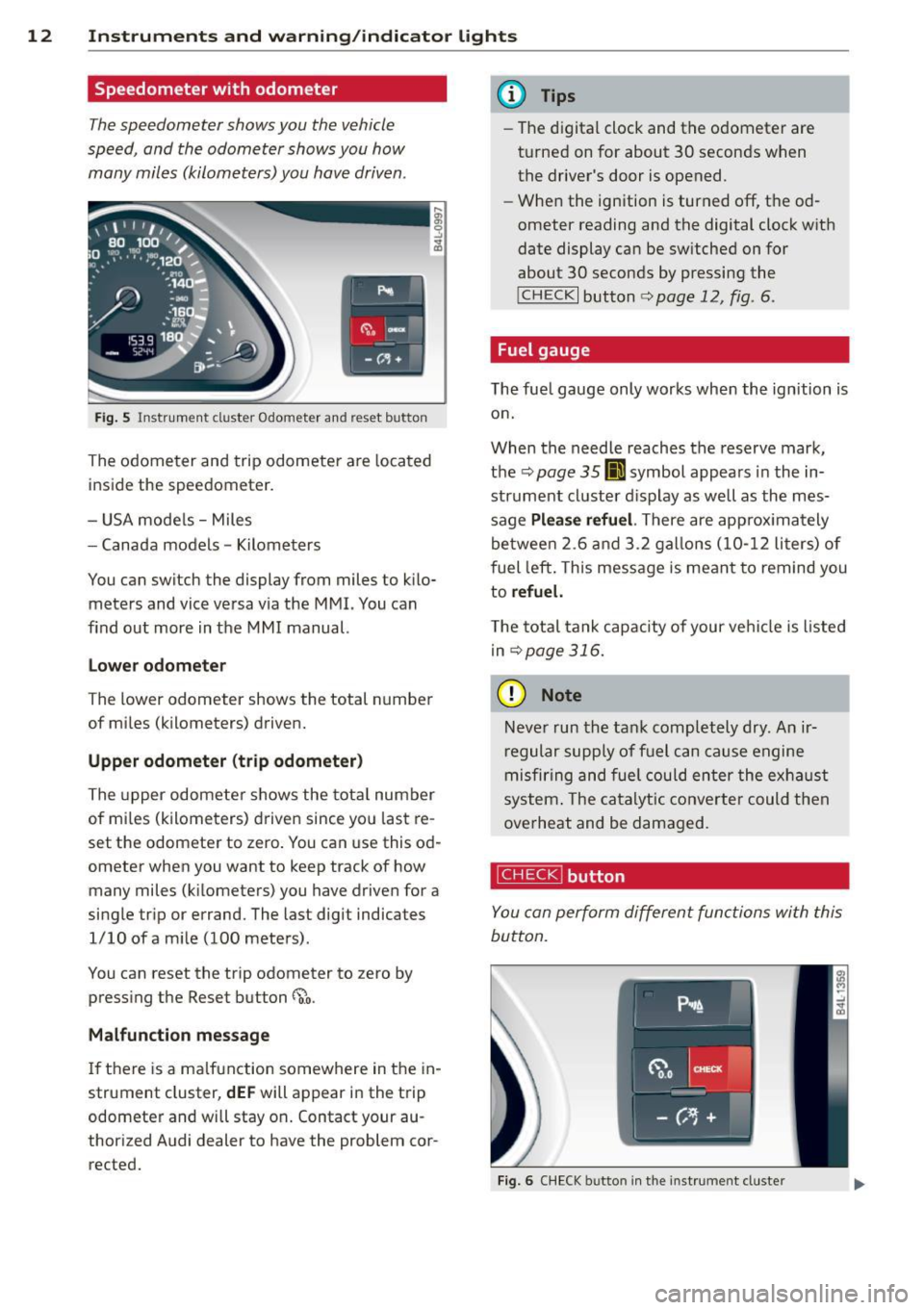
12 Instruments and warning/indicator lights
Speedometer with odometer
The speedometer shows you the vehicle
speed, and the odometer shows you how many miles (kilometers) you have driven .
Fig. 5 Instrum ent cl ust er Odo mete r an d re set bu tton
The odometer and trip odometer are located
i nside the speedometer.
- USA mode ls - Miles
- Canada models -Kilometers
You can sw itch the display from miles to kilo
meters and vice versa via the MM I. You can
find out more in the MMI manual.
Lower odometer
The low er odometer shows the total number
of mi les (kilometers) driven.
Upper odometer (trip odometer)
The upper odometer shows the tota l number
of mi les (kilometers) driven since you last re
set the odometer to zero. You can use this od
ometer when you want to keep t rack of how
many miles (k ilometers) you have driven for a
single trip or errand. The last digi t indica tes
1/10 of a mile (100 meters) .
You can reset the trip odometer to zero by
pressing the Reset button
~o.
Malfunction message
If there is a malfunction somewhere in the in
strument cluster,
dEF will appear in the trip
odometer and will stay on. Contact your au
thori zed Aud i dealer to have the problem cor
rected.
(D Tips
- The digital clock and the odometer are
turned on for about 30 seconds when
the driver's door is opened.
- When the ignition is turned off, the od
ometer reading and the digital clock with
date display can be sw itched on for
about 30 seconds by pressing the
! CHECK I button ¢ page 12, fig . 6 .
Fuel gauge
The fuel gauge only works when the ignition is
on.
When the needle reaches the reserve mark,
the ~
page 35 (i symbol appears in the in
strument cluster d isplay as well as the mes
sage
Plea se refuel. There are app rox imately
between
2.6 and 3 .2 gallons (10-12 liters) of
fuel left . This message is meant to remind you
to
refuel.
T he total tank capacity of your vehicle is l isted
i n
¢ page 316.
(D Note
Never run the tank completely dry . An ir
regular supply of fuel can cause engine
misfiring and fuel could enter the exhaust
system . The catalytic converter could then
overheat and be damaged .
~button
You can perform different functions with this
button.
Fig. 6 CHECK butto n in the instrument cluste r
Page 17 of 342
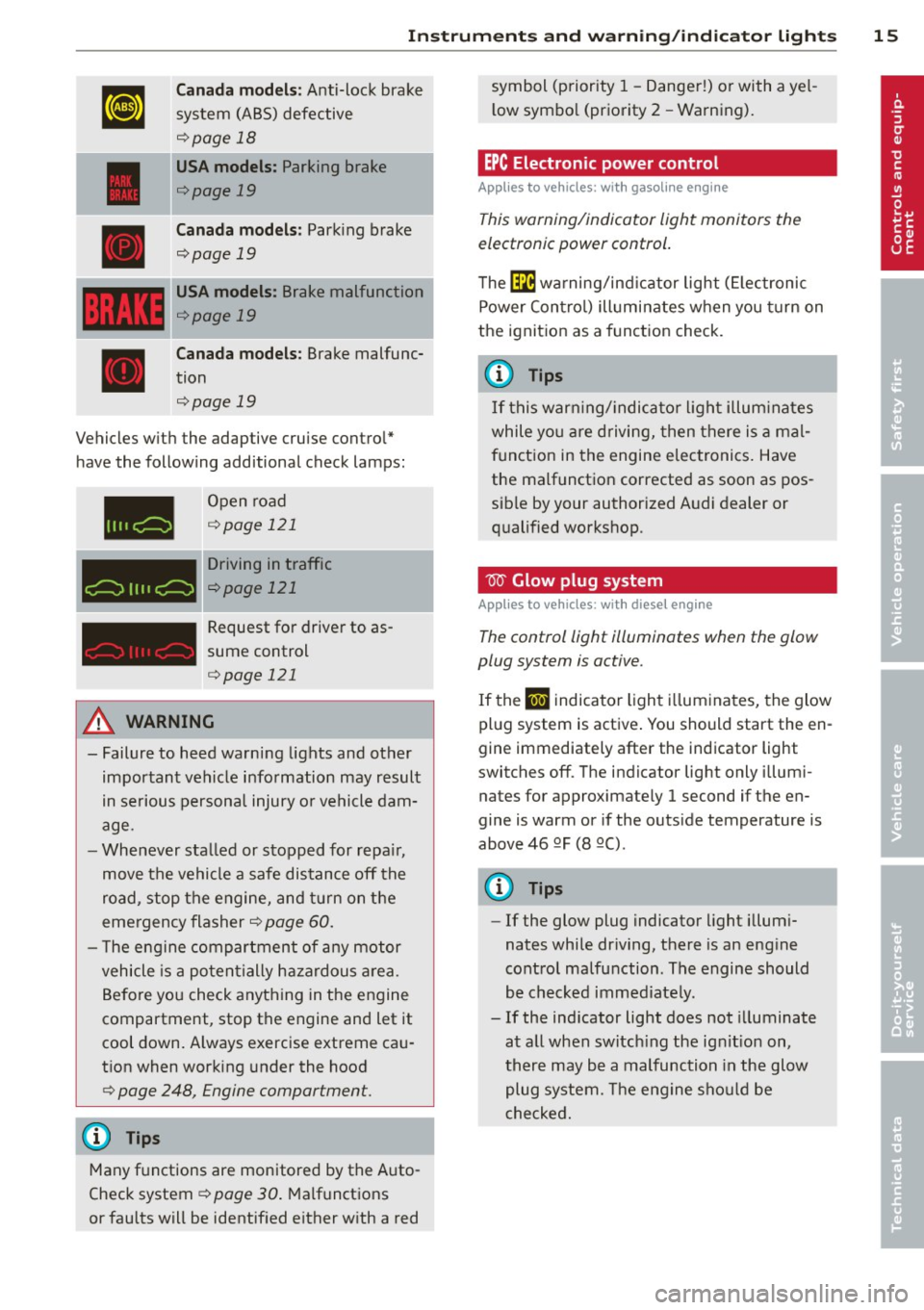
Instrument s and warnin g/indic ator ligh ts 15
Canada m od els: Anti-lock brake
system (ABS) defective
¢page 18
USA models: Parking brake
¢page 19
Canada m od els: Park ing brake
¢page 19
USA models : Brake malfunction
¢page 19
Canada models : Brake malfunc
tion
¢page 19
Vehicles w ith the adaptive cruise control*
have the following additional check lamps :
-
Open road
¢page 121
Driving in traffic
¢page 121
Request for drive r to as
sume control
¢page 121
A WARNING
-Failure to heed warning lights and other
important vehicle information may result
in serious persona l injury o r vehicle dam
age.
- Whenever sta lled or stopped for repa ir,
move the vehicle a safe distance
off t he
road, stop the engine, and turn on the
emergency flasher¢
page 60.
-The e ngine compartment of a ny motor
vehicle is a potentially h azardous area.
Be fore you check anything in the engine
compartment, stop the engine and let it
cool down. Always exercise extreme ca u
t ion when working under the hood
¢ page 248, Engine comportment.
Many f unctions are monitored by the A uto
Check system¢
page 30 . Malfunctions
or faults will be identif ied either w ith a red symbol (priority
1 -Danger!) or with a ye l
l ow symbo l (prio rity
2 - Warning).
EPC Electronic power control
Applies to vehicles : with gasoline engine
This warning/indicator light monitors the
electronic power control .
The ~ warning/ind icator light ( Electronic
Power Contro l) illuminates when you turn on
the ignit ion as a f unct ion check.
(D Tips
If this war ning/ indica to r light illum inates
while yo u are d riving, then there is a mal
funct ion in the engine electronics. Have
the malfunct ion corrected as soon as pos
sib le by your authorized A udi dealer or
qualified workshop.
W Glow plug system
App lies to vehicles: wit h diese l eng ine
The control light illuminates when the glow
plug system is active.
If the mlJ indicator light illum inates, the glow
pl ug system is act ive . You should start the en
gine immediately after the indicator light
switches
off. The indicator light only illum i
nates for approximate ly 1 second if the en
gine is warm or if the outs ide temperature is
above 46 QF (8 QC) .
(D Tips
- If the glow plug indicator light i llum i
nates while dr iving, there is an eng ine
cont rol malfunction . The engine should
be checke d immed iate ly .
- If the ind icator light does not illuminate
at a ll when switch ing the ig nit ion on,
there may be a malfunction in the glow
plug system. The engine sho uld be
c hecke d.
Page 19 of 342
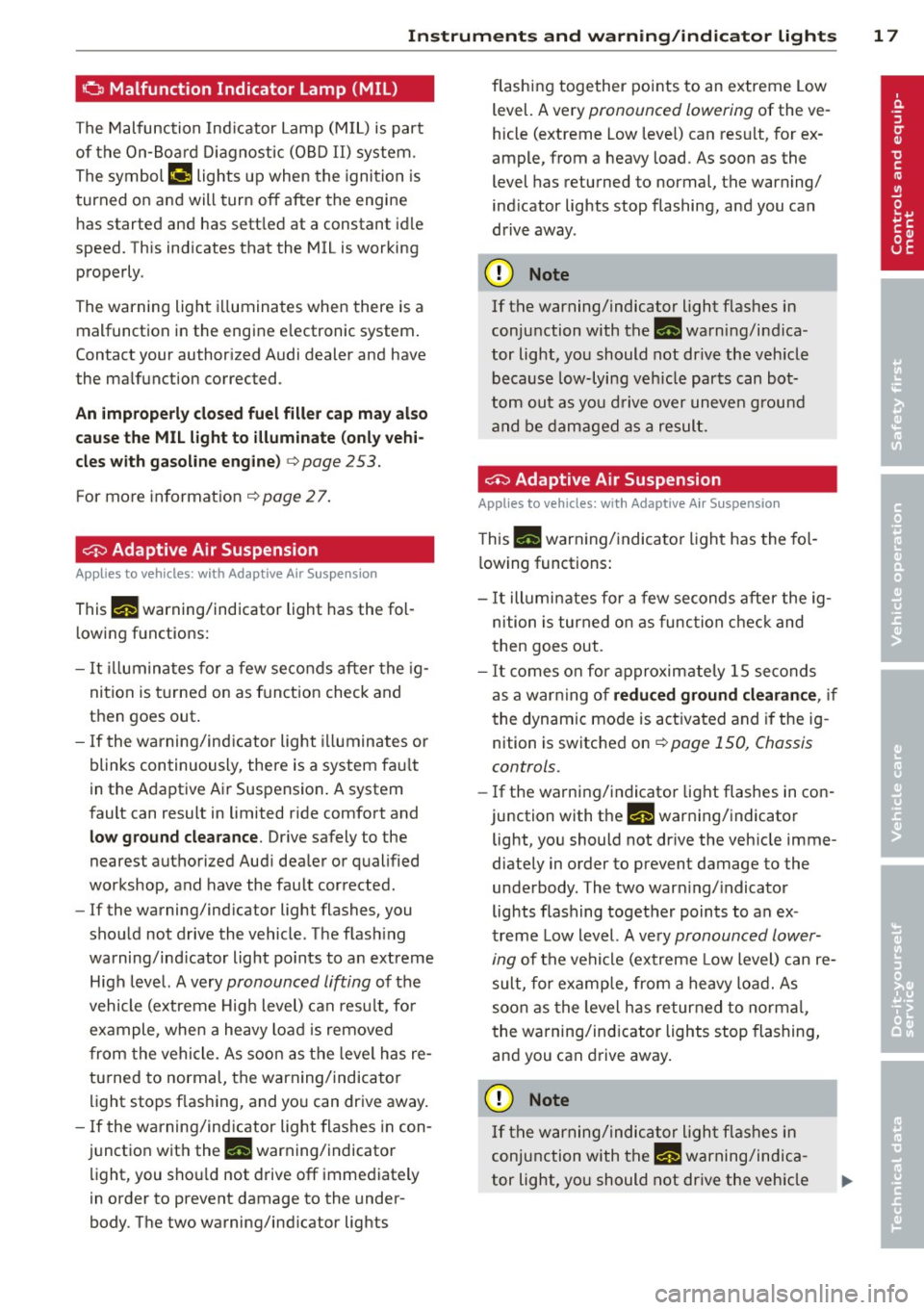
Instruments and warning/indicator lights 17
o Malfunction Indicator Lamp (MIL)
The Malfunction Indicator Lamp (M IL) is part
of the On-Board Diagnostic (OBD II) system.
The symbol
f• lights up when the ignition is
turned on and will turn off after the engine
has started and has sett led at a constant idle
speed. Th is ind icates that the MIL is working
properly.
The warning light illuminates when there is a
malfunction in the engine electronic system .
Contact your author ized Audi dealer and have
the ma lfunction corrected.
An improperly closed fuel filler cap may also
cause the MIL light to illuminate (only vehi
cles with gasoline engine)
c:> page 253.
For more informat ion c:> page 2 7.
0 Adaptive Air Suspension
Applies to vehicles: with Adaptive Air Suspension
This II warning/indicator light has the fol
l owing functions:
- It illuminates for a few seconds after the ig
nition is turned on as function check and
then goes out .
- If the warning/ind icator light illuminates or
blinks continuously, there is a system fau lt
in the Adaptive A ir Suspension . A system
fault can result in limited ride comfort and
low ground clearance . Drive safely to the
nearest authorized Aud i dealer or qualified
workshop, and have the fault corrected .
- If the warning/ind icator light flashes, you
should not drive the vehicle. The flash ing
warning/ind icator light po ints to an extreme
High level. A very
pronounced lifting of the
vehicle (extreme High level) can resu lt, fo r
example, when a heavy load is removed
from the vehicle. As soon as the leve l has re
turned to normal, the warning/indicator
light stops flashing, and you can drive away.
- If the warning/ind icator light flashes in con
junction with the
II warning/indicator
light, you sho uld not drive off immediately
i n order to prevent damage to the under
body. The two warning/ind icator lights flashing together points to an extreme Low
level. A very
pronounced lowering of the ve
hicle (extreme Low leve l) can result, for ex
ample, from a heavy load. As soon as the
level has retu rned to normal, the warning/
ind icator lights stop flashing, and you can
drive away.
(D Note
If the warning/indicator light flashes in
conjunction with the
II warni ng/indica
tor light, you should not dr ive the veh icle
because low-lying vehicle parts can bot
tom out as you drive over uneven ground
and be damaged as a result.
~ Adaptive Air Suspension
Applies to vehicles: with Adaptive Air Suspension
This II warning/ indicator light has the fol
lowing functions:
- It illuminates for a few seconds after the ig
nition is turned on as function check and
then goes out.
- It comes on for approximately 15 seconds
as a warning of
reduced ground clearance , if
the dynamic mode is activated and if the ig
nition is switched on
r:!;> page 150, Chassis
controls.
- If the warning/indicator light flashes in con
junction with the
II warning/indicator
light, you should not drive the vehicle imme
diately in order to prevent damage to the
underbody. The two warn ing/ indicator
lights flashing together points to an ex
treme Low level. A very
pronounced lower
ing
of the vehicle (extreme Low level) can re
sult, for example, from a heavy load. As
soon as the level has returned to normal,
the warning/indicator lights stop flashing,
and you can drive away.
(D Note
If the warning/indicator light flashes in
conjunction with the
II warning/indica
tor light, you should not drive the vehicle
Page 32 of 342
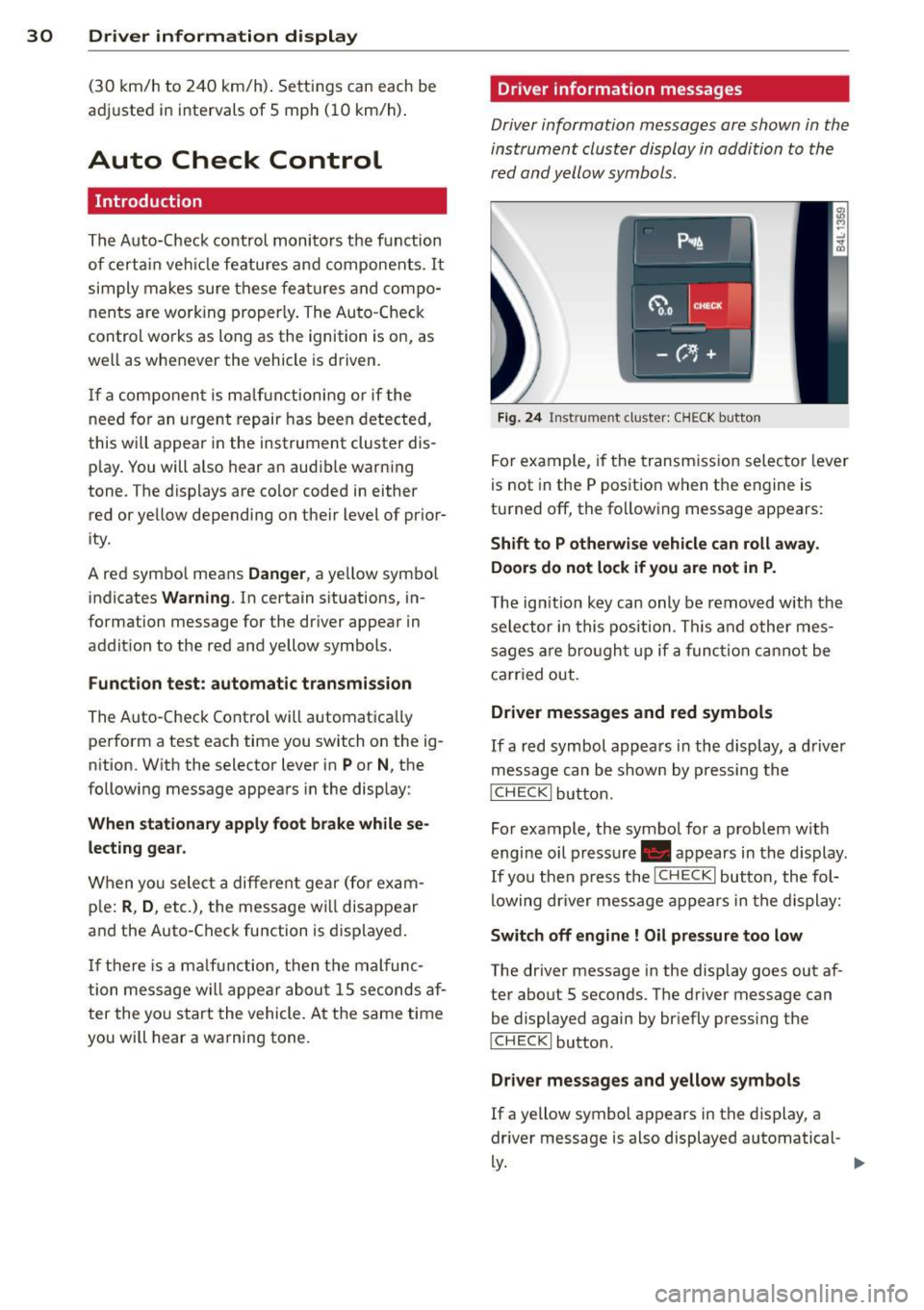
30 Driver in formation d ispl ay
(30 km/h to 240 km/h) . Settings can each be
adj usted in intervals of S mph (10 km/h) .
Auto Check Control
Introduction
The Auto-Check control monitors the function
of certain veh icle featu res and components . It
simply makes sure these features and compo nents are work ing proper ly . The Auto -Check
contro l wo rks as long as the ignition is on, as
well as whenever the vehicle is driven.
If a componen t is ma lf u nctioning or if the
n eed for an urgent repair has been detected,
this will appear in the instrument cluster dis
p lay . You w ill a lso hear an audible warn ing
tone . The displays are co lor coded in e ither
red or yellow depending on their level of prior
ity .
A red symbo l means
Dange r, a yellow symbo l
indic ates
Warning . In certain s ituations, in
formation message for the dr iver appear in
addit ion to the red and yellow symbols.
Function te st : automat ic transmi ssion
The Auto -Check Control will automat ica lly
perform a test each time you switch on the ig
n ition. With the selector lever in
P or N , the
following message appears in the display :
When station ary apply foot br ake while s e
lecting gear .
When you select a different gear (for exam
p le :
R , D , etc.), the message wi ll disappear
and the Auto-Check function is d isplayed .
I f there is a m alfu nction, then the malfunc
tion message w ill appear about 15 seconds af
ter the yo u start the vehicle. At t he same time
you will hear a warning tone .
Driver information messages
Driver information messages are shown in the
instrument cluster display in addition to the
red and yellow symbols .
Fig. 24 Ins trume nt cl ust er: CHECK b utto n
For example, if the transmiss ion selec to r l ever
is not in the P position when the engine is
turned off, the following message appears :
Shift to P otherwise vehicle can roll away.
Door s do not l ock if you are not in P .
The ig nition key can only be removed with the
selector in this position . Th is and other mes
sages are bro ugh t up if a func tion cannot be
carr ied out.
Driver messages and red symbols
If a red symbol appea rs in the display, a d river
message can be shown by pressing the
I CH ECK I button.
For example, the symbo l for a problem w ith
engine oil p ressure . appears in the display.
If you then p ress the
I CHECK I button , the fol
lowing dr iver message appears in the display:
Switch off engine ! Oil pr essure too low
The driver message in the display goes out af
ter about 5 seconds . The driver message can
be displayed again by briefly press ing the
I CH ECKi button.
Driver me ssages and yellow symbol s
If a yellow symbol appears in the display, a
driver message is also displayed automatical-
~ ~
Page 33 of 342
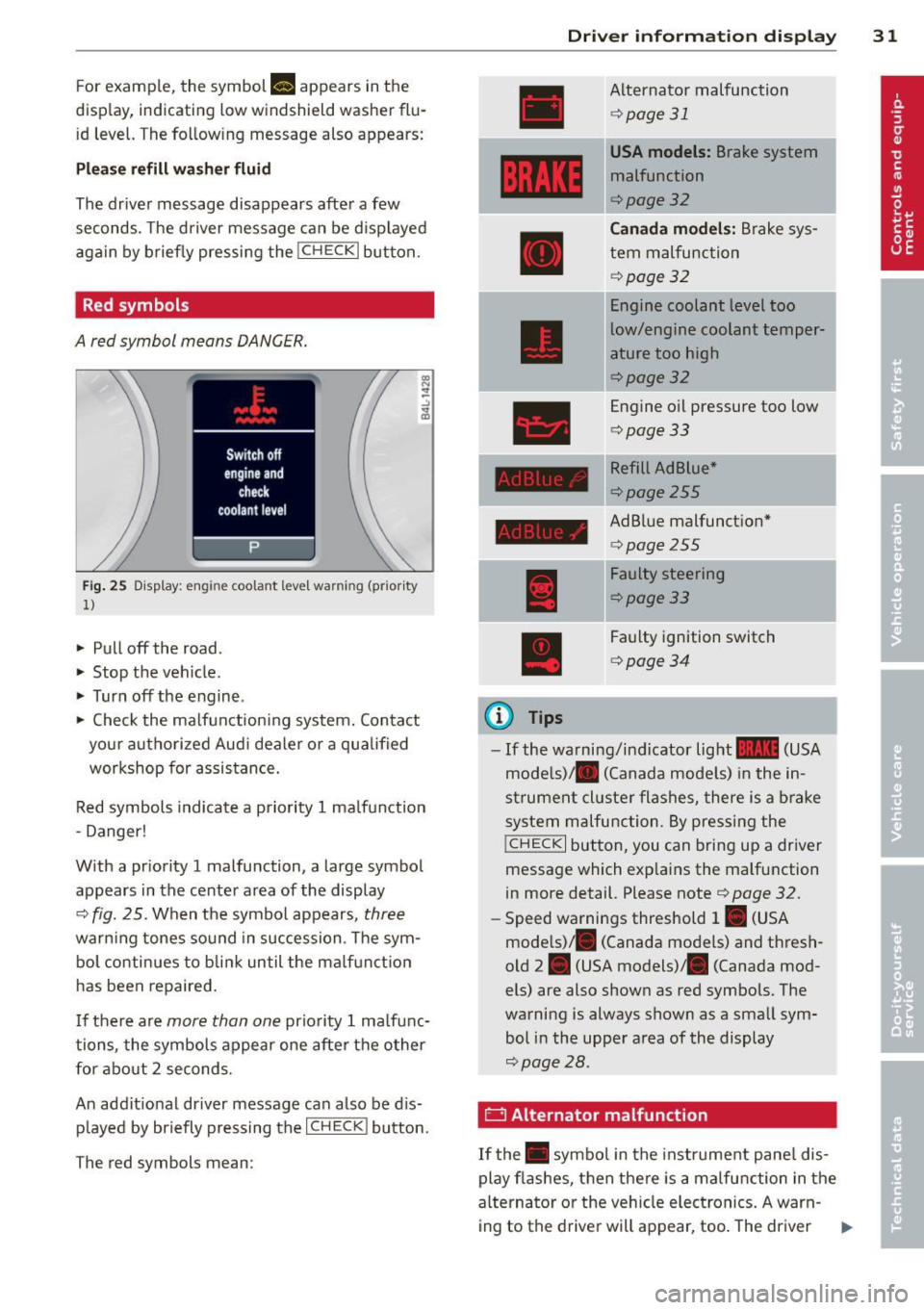
For example, the symbol Ill appears in the
display, indicating low windshield washer flu
id level. The follow ing message also appears:
Pl eas e refill w asher flu id
The driver message disappears after a few
seconds. The driver message can be displayed
again by briefly pressi ng the
!CHECK I button.
Red symbols
A red symbol means DANGER.
Fig. 25 Display: engine coolant level warning (pr ior ity
1)
• Pull off the road .
• Stop the veh icle.
• Turn off the engine .
• Check the ma lfunctioning system. Contact
your authorized Aud i dea ler or a qualified
workshop for assistance.
Red symbols indicate a priority 1 ma lf u nction
- Danger!
W ith a pr iority 1 malfunction, a large symbol
appears in the center area of the display
¢ fig. 25. When the symbol appears, three
warning tones sound in succession . T he sym
bol co nti nues to bli nk until the ma lf u nct ion
has been repaired.
I f there are
more than one prio rity 1 ma lfunc
tions, the symbols appear one after the other
for about 2 seconds.
An addit ional driver message can also be d is
p layed by briefly pressing the
I CHECK ! button.
The red symbols mean:
Driver inform ation di spl ay 31
@ Tips
Alternato r malfunction
<:!> page 31
USA models: Brake system
malfunction
r:!>page32
Can ad a mod els : B rake sys
tem malfunc tion
r:!> page32
Engine coolant level too
low/engine coolant temper
ature too high
<:!>page 32
Engine oil pressure too low
<:!>page 33
Refill Ad Blue*
¢page255
AdBlue malfunction*
<=> page255
Faulty steering
r:!>page33
Fa ulty ignition switch
<=>page34
-If the wa rning/ind icator light 11111 (USA
mode ls)/ . (Canada mode ls) in the in
strument cluste r flashes, there is a brake
system malfunction. By pressing the
! CHECK I but ton, you can bring up a driver
message which explains the malfunction
in more detail. Please note
r:!> page 32.
-Speed warnings threshold 1. (USA
mode ls)/ . (Canada models) and thresh
old 2. (USA
models) ta (Canada mod
els) are also shown as red symbols. The
warning is always shown as a small sym
bol in the upper area of the display
r:!> page 28 .
0 Alternator malfunction
If the . symbo l in the instrument pane l dis
play flashes, then there is a malfu nction in the
alternator or the vehicle elect ron ics. A warn -
ing to the driver will appear, too. The driver ..,_
Page 34 of 342
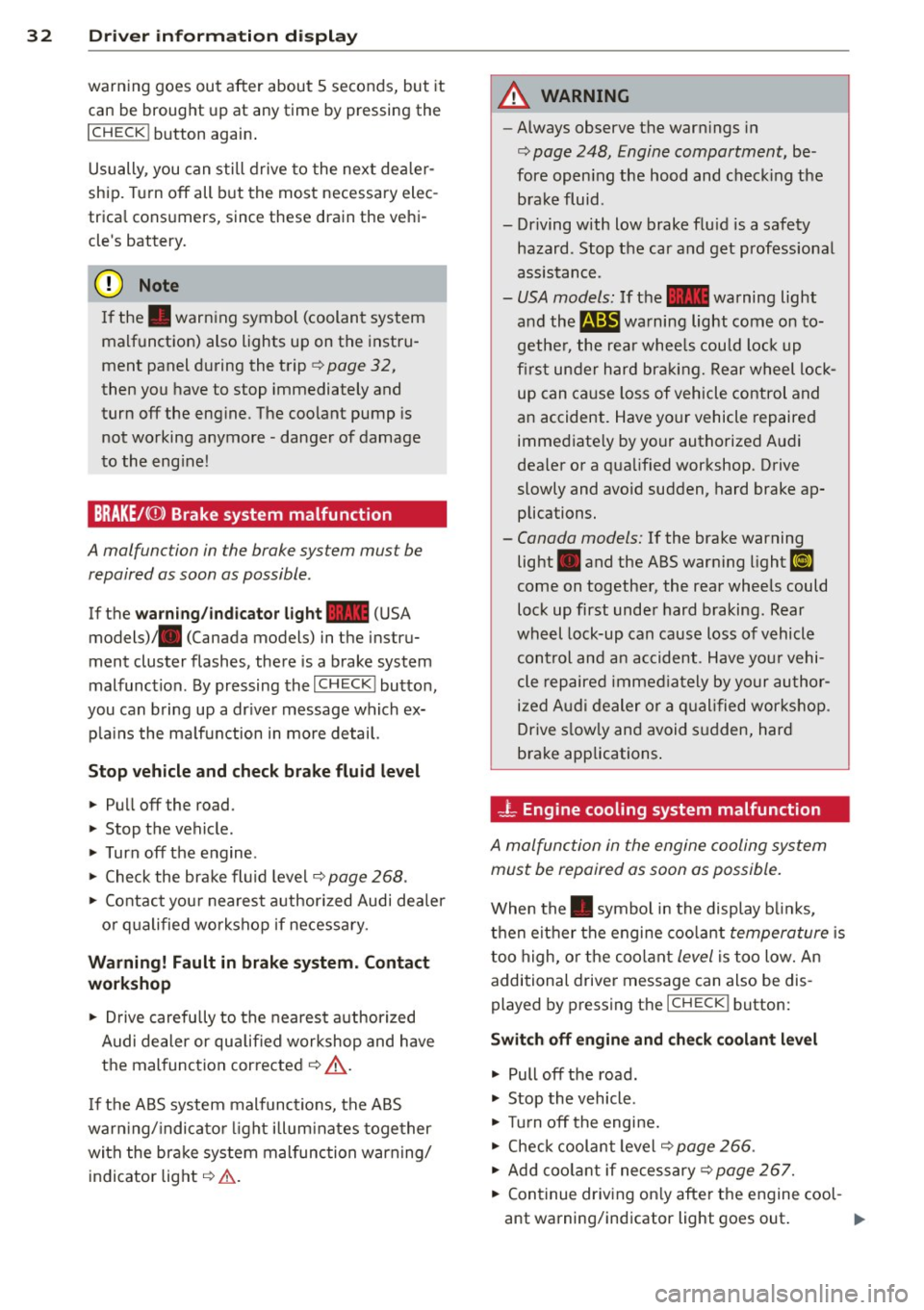
32 Driver information display
warning goes out after about 5 seconds, but it
can be brought up at any time by pressing the
I CHECK ! button again.
Usually , you can still drive to the next dealer
ship. Turn off all but the most necessary elec
trica l consumers, since these drain the vehi
cle's battery.
(D Note
If the . warning symbol (coolant system
malfunction) also lights up on the instru
ment panel during the trip
¢ page 32,
then you have to stop immediately and
turn off the engine. The coolant pump is
not working anymore -danger of damage
to the engine!
BRAKE/( ©) Brake system malfunction
A malfunction in the brake system must be
repaired as soon as possible .
If the warning/indicator light-(USA
models)/ . (Canada models) in the instru
ment cluster flashes, there is a brake system
malfunction. By pressing the
I CHECK ! button,
you can bring up a driver message which ex
plains the malfunction in more detail.
Stop vehicle and check brake fluid level
> Pull off the road .
> Stop the vehicle.
> Turn off the engine.
> Check the brake fluid level¢ page 268 .
> Contact your nearest authorized Audi dealer
or qualified workshop if necessary.
Warning! Fault in brake system. Contact
workshop
> Drive carefully to the nearest authorized
Audi dealer or qualified workshop and have
the malfunction corrected ¢
&_.
If the ABS system malfunctions, the ABS
warning/indicator light illuminates together
with the brake system malfunction warning/ indicator light¢&. .
A WARNING
-Always observe the warnings in
¢ page 248, Engine compartment, be
fore opening the hood and checking the brake fluid .
- Driving with low brake fluid is a safety
hazard . Stop the car and get professional
assistance .
-USA models: If the - warning light
and the
B warning light come on to
gether, the rear wheels could lock up
first under hard braking. Rear wheel lock
up can cause loss of vehicle control and
an accident. Have your vehicle repaired
immediately by your authorized Audi
dealer or a qualified workshop. Drive
slowly and avoid sudden, hard brake ap
plications.
- Canada models: If the brake warning
light . and the ABS warning light
II]
come on together, the rear wheels could
lock up first under hard braking . Rear
wheel lock-up can cause loss of vehicle
control and an accident . Have your vehi
cle repaired immediately by your author
ized Audi dealer or a qualified workshop .
Drive slowly and avoid sudden, hard
brake applications.
- L Engine cooling system malfunction
A malfunction in the engine cooling system
must be repaired as soon as possible.
When the. symbol in the display blinks,
then either the engine coolant
temperature is
too high, or the coolant
level is too low. An
additional driver message can also be dis
played by pressing the
I CHECK! button:
Switch off engine and check coolant level
> Pull off the road.
> Stop the vehicle .
> Turn off the engine.
> Check coolant level¢ page 266 .
> Add coolant if necessary¢ page 267.
> Continue driving only after the engine cool-
ant warning/indicator light goes out.
1J>